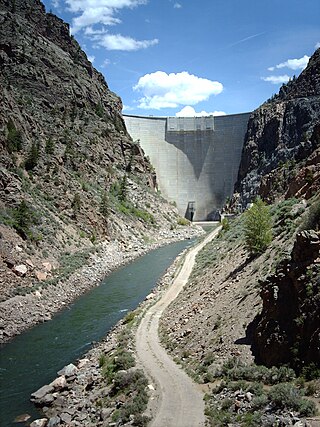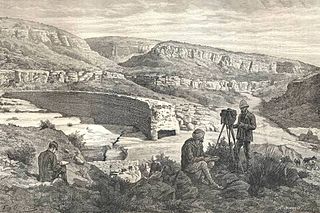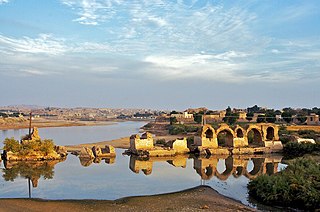Related Research Articles

Lusitania was an ancient Iberian Roman province comprising part of modern Portugal and a large portion of western Spain. Romans named the region after the Lusitanians, an Indo-European tribe inhabiting the lands.

A dam is a barrier that stops or restricts the flow of surface water or underground streams. Reservoirs created by dams not only suppress floods but also provide water for activities such as irrigation, human consumption, industrial use, aquaculture, and navigability. Hydropower is often used in conjunction with dams to generate electricity. A dam can also be used to collect or store water which can be evenly distributed between locations. Dams generally serve the primary purpose of retaining water, while other structures such as floodgates or levees are used to manage or prevent water flow into specific land regions.

Ancient Roman architecture adopted the external language of classical ancient Greek architecture for the purposes of the ancient Romans, but was different from Greek buildings, becoming a new architectural style. The two styles are often considered one body of classical architecture. Roman architecture flourished in the Roman Republic and to an even greater extent under the Empire, when the great majority of surviving buildings were constructed. It used new materials, particularly Roman concrete, and newer technologies such as the arch and the dome to make buildings that were typically strong and well engineered. Large numbers remain in some form across the former empire, sometimes complete and still in use today.

An arch dam is a concrete dam that is curved upstream in plan. The arch dam is designed so that the force of the water against it, known as hydrostatic pressure, presses against the arch, causing the arch to straighten slightly and strengthening the structure as it pushes into its foundation or abutments. An arch dam is most suitable for narrow canyons or gorges with steep walls of stable rock to support the structure and stresses. Since they are thinner than any other dam type, they require much less construction material, making them economical and practical in remote areas.

Dara or Daras was an important East Roman fortress city in northern Mesopotamia on the border with the Sassanid Empire. Because of its great strategic importance, it featured prominently in the Roman-Persian conflicts. The former archbishopric remains a multiple Catholic titular see. Today, the village of Dara, in the Mardin Province occupies its location.

The Alcantarilla Dam is a ruined Roman gravity dam in Mazarambroz, Toledo province, Castilla-La Mancha, Spain, dating to the 2nd century BC. The toponym "Alcantarilla" means conduit and is of Arabic origin: the Latin name is unknown.
The Esparragalejo Dam was a Roman multiple arch buttress dam at Esparragalejo, Badajoz province, Extremadura, Spain. Dating to the 1st century AD, it is the earliest known multiple arch dam.

The Glanum Dam, also known as the Vallon de Baume dam, was a Roman arch dam built to supply water to the Roman town of Glanum, the remains of which stand outside the town of Saint-Rémy-de-Provence in Southern France. It was situated south of Glanum, in a gorge that cut into the hills of the Alpilles in the Roman province of Gallia Narbonensis. Dating to the 1st century BC, it was the earliest known dam of its kind. The remains of the dam were destroyed during the construction of a modern replacement in 1891, which now facilitates the supply of water to Saint-Rémy-de-Provence in the Bouches-du-Rhône region of France.

The Kasserine Dam was a Roman dam at Kasserine, Tunisia. The curved structure which dates to the 2nd century AD is variously classified as arch-gravity dam or gravity dam.
The Dara Dam was a Roman arch dam at Dara in Mesopotamia, a rare pre-modern example of this dam type. The modern identification of its site is uncertain, but may rather point to a common gravity dam.

The Lake Homs Dam, also known as Qattinah Dam, is a Roman-built dam near the city of Homs, Syria, which is in use to this day.

The Grane Dam is a dam above the village of Astfeld/Herzog-Juliushütte in the borough of Langelsheim in the Lower Saxon part of the Harz mountains.

The Shushtar Historical Hydraulic System is a complex irrigation system of the island city Shushtar from the Sassanid era. It consists of 13 dams, bridges, canals and structures which work together as a hydraulic system.

The Band-e Kaisar, Pol-e Kaisar, Bridge of Valerian or Shadirwan was an ancient arch bridge in the city of Shushtar, Khuzestan province, Iran, and the first in the country to combine it with a dam. Built by the Sassanids, using Roman prisoners of war as workforce, in the 3rd century AD on Sassanid order, it was also the most eastern example of Roman bridge design and Roman dam, lying deep in Persian territory. Its dual-purpose design exerted a profound influence on Iranian civil engineering and was instrumental in developing Sassanid water management techniques.

The Roman Dam of Belas is a 3rd-century Roman barrier constructed to serve the city of Olisipo, located in civil parish of Queluz e Belas, municipality of Sintra.
Troy Township is a township in Iowa County, Iowa, USA.
Clay Township is an inactive township in Lafayette County, in the U.S. state of Missouri.

The Roman Dam of Pego da Moura is a small buttress dam situated in the municipality of Grândola in the Setúbal District of Portugal.
References
- 1 2 Decker 1991 , pp. 78–79 (no. 4)
